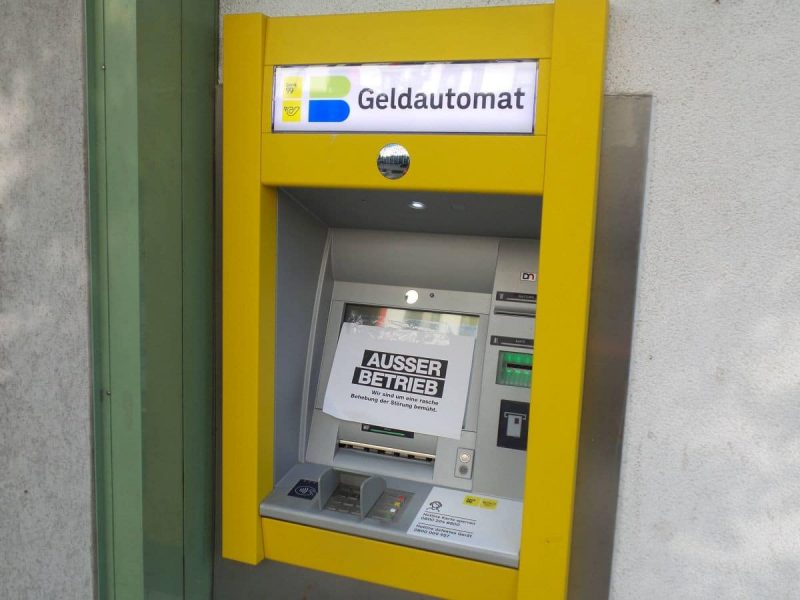Very few vacation spots do not have any cash at all. Again and again you come across a shop or a rental of beach chairs that operates according to the motto "Cash is King". Obtaining cash from ATMs can be quite expensive in some regions. With a few simple "ticks" it is also much cheaper or even free.
First of all, you should know that there are several cost traps when using ATMs abroad. The best known by now: ATMs from Euronet and other operators that seem to be on every corner in holiday regions. As a rule, these require a so-called direct customer fee. Specifically, this means that in addition to the withdrawal amount, Euronet, for example, bills and debits five euros.
Horrific "direct customer fees"
In the European Union, operators of ATMs are obliged to point out any fees. The “expensive ATMs” do not actually comply with this in all countries or in a way that is immediately understandable for the customer. Unless you are acutely dependent on cash, you should abort the process and use a machine located on the facade or in the foyer of a bank. In most cases, they charge lower customer charges and, with a little luck, none at all.
ATMs are real money printing machines in tourist areas, because the card-issuing bank has to pay a fixed fee to the operator to use them. The customer does not notice any of this. But that is not enough for many ATM operators and an additional fee is charged directly to the customer. If the house bank (card issuer) charges a fee for the use of ATMs, then the direct customer fee comes on-top. Put simply: You even pay twice for withdrawals from the machine.
By the way: Such money-hungry ATMs can be found not only abroad or in holiday regions, but also in Germany they are literally sprouting up like mushrooms. Therefore it is better to walk or drive a few meters further at home if the ATM wants to charge a direct customer fee for its "service". In Austria, some credit institutions are particularly bold: Probably for visual reasons, no fee is charged when inserting an Austrian card, but it does for "foreigners". In such a case you should definitely look for another dispenser. The same phenomenon can be observed in Malta even at the machines of relevant rip-off operators.
Rip off by means of a terrible exchange rate
A second scam can be found in non-euro countries: the "friendly" ATM offers conversion and debiting in euros. Very practical at first glance, but this option should definitely not be used. The reason for this is simple: A basket money is generated via terribly bad exchange rates.
The debit should therefore always be made in the local currency and the conversion is then carried out by the house bank. This usually grants a better course. Just don't let yourself be frightened by downright scare tactics: the conversion through the house bank is not that expensive.

Many banks charge fees abroad
The card-issuing banks can have another cost trap in store, as many charge fees for use outside the euro zone. Often these are referred to as foreign transaction fees or foreign currency fees. The majority of banks charge a fee for every payment transaction or every cash withdrawal that is not made in euros. This is usually much lower than that which is charged directly at the ATM by the operator using terrible exchange rates.
Some banks do not have foreign currency fees. Whether the card issuer collects any or not can only be answered by asking the bank advisor or looking at the price list. Therefore, you should definitely make yourself familiar with it before traveling. Sometimes it can be useful to organize a prepaid card with no international fees for the trip in advance. There are now many providers in the fintech sector.
Customers of German banks should also exercise great caution, because some institutions even charge horrific fees for withdrawals from ATMs within the euro zone. Five euros and more are not uncommon. Such credit institutions also charge this fee domestically when withdrawing from ATMs of other banks. Austrian bank customers are mostly not affected by this rip-off trap, as there are only very few credit institutions of this kind.

Credit or debit can make a difference
But which card do you use to withdraw cash abroad? Debit or credit card? This question is a complicated one to answer. Just a few years ago, pretty much all credit card issuers charged heavy fees for cash withdrawals. Many Mastercard and Visa card issuers, especially those from the fintech sector, do not charge any fees. There are also blatant special cases: For example, Fintech N26 always charges a fee for withdrawals with the Maestro card - also in Germany. However, if the Debit Mastercard is inserted into the machine, there is - at least from the issuing bank - no or a significantly lower fee.
In some countries you don't have a choice whether the Maestro card or the Mastercard / Visa card goes into the machine, because Maestro / Vpay are not accepted at all. This is often the case in many countries that never had the Maestro or Vpay brands, which are now being phased out, but instead Visa Debit and Debit Mastercard.
Before traveling, you should therefore clarify whether the debit or credit card has lower or, ideally, no fees at all for withdrawing cash and paying at the point of sale. Information on this can be found in the price list of the respective bank. If anything is unclear, you should contact the bank advisor or customer service department of the credit institution before you travel.
Just a few years ago it was clear that if Vpay or Maestro was on the card, then it was an ATM card. For example Visa or Mastercard were credit cards or so-called prepaid credit cards, at least in Austria and Germany. But that has changed, because more and more banks in the DA-CH region are switching from Maestro to Debit Mastercard or from Vpay to Visa Debit. The advantages for customers: The new cards are accepted almost all over the world, and payments can also be made on the Internet.
But the banks do not make it easy for their customers, because many credit institutes also issue the new debit cards with embossing so that they look like a "real" credit card. The EU has come up with something: If the word “Debit” is on the card, then it is a debit card, ie an ATM card. If “Credit” can be read, it is a credit card.
The difference between debit and credit is usually as follows: Payments or cash withdrawals with debit cards (ATM cards) are debited from the bank account immediately or very promptly. In the case of credit cards, sales are collected and debited once a month or must be transferred by the customer himself.
There is also a special feature that, for example, the Dutch bank Bunq has brought onto the market. This has "credit cards" on offer, which have the word Credit printed on them and also come out as credit cards at the terminal. However, they are not real credit cards, because the limit is set to 0 euros. No money in the account means no payment. Rule of thumb: With a real credit card, the so-called credit line can usually be found on the monthly bills.
Overview of the common card brands
| ATM card (debit) | Credit card (credit) |
| Teacher | Mastercard Credit |
| vpay | visa credit |
| Debit mastercard | American Express |
| Visa Debit | Diners Club |
| giro card |





 trail (for them it's free to use)
trail (for them it's free to use)